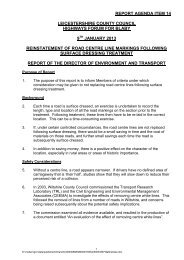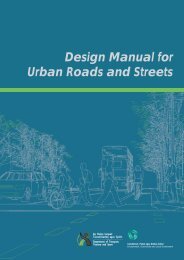Pedestrian Comfort Guidance for London
Pedestrian Comfort Guidance for London
Pedestrian Comfort Guidance for London
Create successful ePaper yourself
Turn your PDF publications into a flip-book with our unique Google optimized e-Paper software.
Appendix D: Measuring <strong>Pedestrian</strong> Activity<br />
This section explains the method <strong>for</strong> collecting pedestrian data, <strong>for</strong> both footways and crossings,<br />
be<strong>for</strong>e detailing the specific data needs <strong>for</strong> each area type. This method is suitable <strong>for</strong> <strong>Pedestrian</strong><br />
<strong>Com<strong>for</strong>t</strong> Level (PCL) Assessments.<br />
Be<strong>for</strong>e carrying out data collection and the <strong>Pedestrian</strong> <strong>Com<strong>for</strong>t</strong> Level assessment you should first<br />
visit your site. When on site you should assess:<br />
•<br />
•<br />
•<br />
•<br />
•<br />
•<br />
Introduction<br />
Site Visit<br />
Is the site the area type you thought it was?<br />
Do the peak hours seem appropriate <strong>for</strong> the full survey?<br />
Are there any locations with high static activity (meeting friends, queuing, taking photographs)<br />
that may require a static activity survey?<br />
Do people cross away from the <strong>for</strong>mal crossing facilities?<br />
Are there signs that the site is a route to and from school? This could include school age children,<br />
school crossing wardens and other indicators such as “only two schoolchildren at a time” signs<br />
on the local shops.<br />
Any other notes about pedestrian activity.<br />
You should follow the Health and Safety procedures of your organisation when going on site.<br />
33




